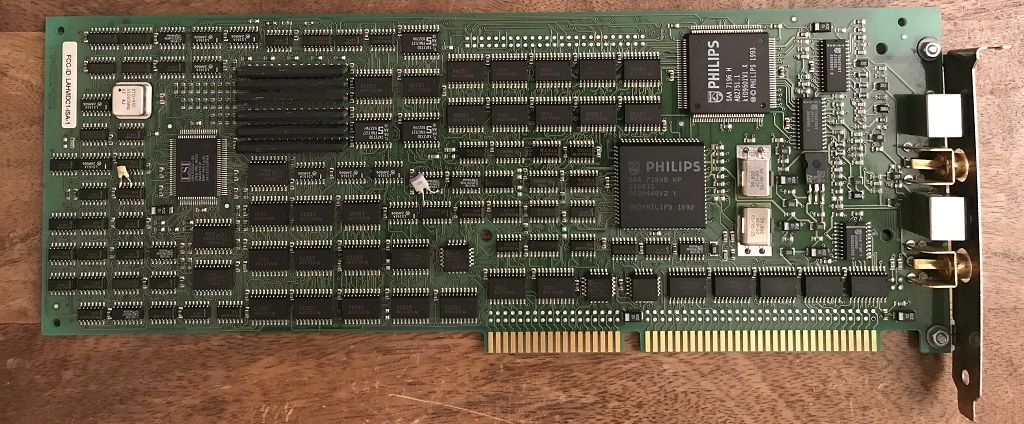
With the help of this board, which was produced in 1994-1995, you can turn a typical computer for that time, well, okay, not into a video studio, of course, but into something that has the ability to non-linear video editing. The sweetest thing for me here is 1994. At least one year before the release of Windows 95. That is, compatible software, with a high degree of probability, will be 16-bit.
warning: a lot of pictures and videos under the cut
From the pictures, I realized that I had acquired something dear to my heart. Yes, this is Miro Video. This is not the kind of miro that miro video player, the open source multi-format player that was very popular at the time, and not exactly the miro that Pinnacle miro video (Pinnacle acquired Miro Computer Systems GmbH in 1997). This is the original, German, like ELSA Technology, dopinnaklovskaya Miro Video DC1 for the 16-bit ISA bus. However, it still has its own community.
Yes, now the enthusiasm for the video digitization board seems strange: I connected the phone via USB, but grab the video files from it with the mouse and transfer it to the computer ... But this was not always the case. This is now any smartphone is capable of shooting video, digitizing and compressing it on the fly. And before the video was shot and stored in analog form: the cameras did not have enough power to digitize and compress on the fly. But computing power is a profitable thing. For our computers (which modern smartphones certainly belong to), it has grown at a gigantic pace since their inception, and digital video makes it possible to very vividly evaluate this pace. Let's count. In order to simply display 4K full-color video on the screen at a speed of 25 frames / sec, the computer must process the data stream at about 600 MiB / sec (3840 * 2160 pixels * 25 times per second * 3 bytes per RGB pixel). This is only the output stream to the video card buffer. Before that, you need to read another stream (although today it is a very compressed stream), read from disk to memory and unpack it. In general, the work for a modern computer is fun: the PCIe 3.0 16x bus has a throughput of about 16 GB / s, and even a 1x PCIe 3.0 slot can theoretically digest up to 1 GB / s, but this is not necessary - there is a compressed stream from the disk , its speed is much lower, and there is a lot of time for receiving / unpacking / sending each of 7 million pixels in a frame of a modern multi-GHz multi-core processor with SIMD instructions. Yes, and RAM for such volumes is more than enough, not to mention disk space.
Now let's get back to our map. 1994 is, in the case of the high-end, the Pentium-90, but the 486DX2-66, in fact, remains a powerful mainstream processor:
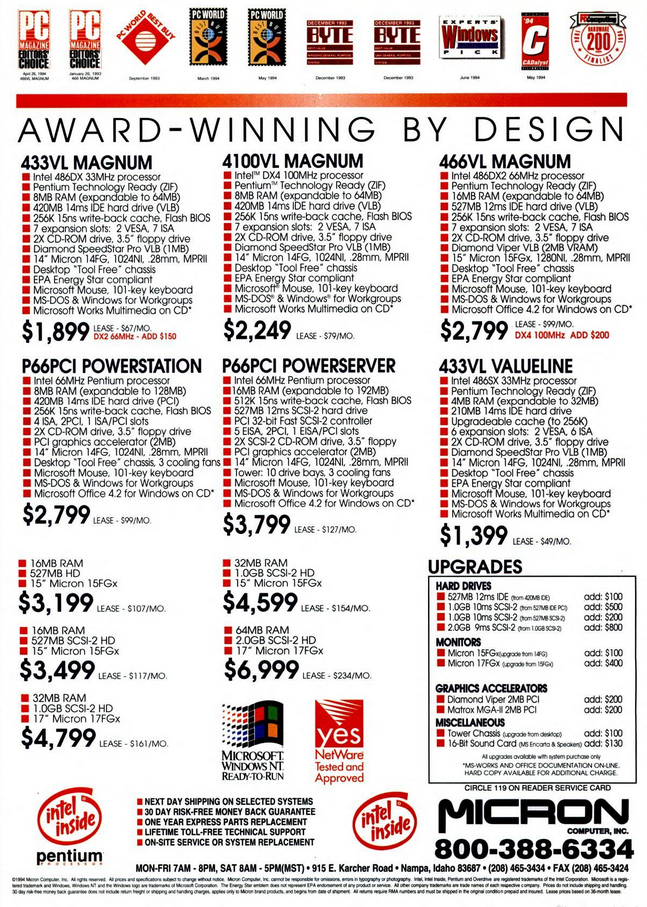
PC Magazine ad for May 1994
Yes, there are already 486 versions at 75 and 100 MHz, but they are mainly in high-end laptop computers. In the low end are 486SX-33 and 486DX-33. Pentium-60 has been on the market for a year now, but is still very expensive. Pentium-90 - something sky-high expensive. So we will build on the 486DX2-66. Pay attention to the volume of the hard drive, 420-520 MB! Less than 1 second of uncompressed 4K video. And in a typical RAM, even 1 frame will not fit.
In this light, the already widespread PCI bus in 1994 does not look such a bottleneck, providing up to 125 MiB of data per second, that is, 1.76 million pixels per frame for full-color video at 25 frames / second. But our capture card is designed for the ISA 16-bit bus, and here everything is much sadder. 8 MHz and 16 bits give a theoretical maximum throughput of 16 MB / s. Or 213 thousand pixels per frame. Even a 640x480 resolution frame has more pixels! And this is a theoretical maximum, in real life unattainable.
In addition, even a video resolution of 320x240 with 8 bits of color and 25 frames / sec - this is more than 1.5 MB / sec, a very serious load for hard drives of that time, which provided a peak linear read speed of 3-5 MB / sec. Well, size matters. Even such an uncompressed video quickly overflows a typical 500 MB disk in literally 5 minutes. Accordingly, we need to compress the data stream, and we have very little headroom on the processing power of the processor!
And this is not all the problems. Modern operating systems have universal frameworks for all occasions. In the days of early Windows, this was not so. There were no standard video codecs in the Windows world, Quicktime remained an Apple exclusive, a typical hardware-software video complex was a thing in itself, incompatible with anything. But in 1992, a package called Video for Windows from Microsoft came out, and wrap it all up ...
Almost. At first, the package did not differ much among users, yet video on computers was still exotic. However, over time, device and application manufacturers have adopted this package, and it has become the de facto standard in the Windows world. It is to this package that we owe the advent of the AVI container. Well, our board also supports this package fully. What well. This means that you can run Adobe Premiere, the first version of which was 16-bit and worked under Windows 3.1 with the Video for Windows package.
Well ok, enough idle thought. It's time to move on to leisure activities. Let's see what the board is made of.

2 VLSIs from Philips, SAA7196 and SAA7199 are immediately apparent. The first one is the Digital Video Decoder, and the second is the encoder. In order not to get confused, I’ll say right away that here the decoder is the ADC, and the encoder is the DAC. The decoder receives separately the luminance and color signals and digitizes them with a sampling rate of 8 bits / count. That is, in fact, we have 16 bits per pixel. To supply individual luminance and color signals, S-Video connectors are installed on the board, but there is also a composite. The decoder was quite skilled, it samples up to 768 pixels per image line, can scale video and convert the YUV color format to RGB.
But that is a decoder. And the board itself, according to the documentation, is capable of capturing video with a resolution of 320x240 in NTSC and 384x288 in PAL / SECAM. However, the board can be used as a hardware codec for resolutions up to 590x442. Wonderful about .
The encoder allows you to output what the decoder enters back to Composite or S-video. Good. Further, among the countless small cases of standard and not very logic, you can see a set of dual-port DRAM chips, standing, in the old fashion, upright.

Its here 768 KiB. And the LSI L64702 JPEG processor.

Yeah, it looks like this board is delivering MJPEG video, that is, a stream of JPEG images. We’ll see this, of course, but in the datasheet on L64702 nothing about temporary compression is visible, so MPEG is hardly here. But for editing it’s even better: all frames are key, loss from clamping will be less. However, this remains to be verified, as is the ability of the card to produce uncompressed video.
In the meantime, let's assemble a computer for the board. Roughly typical for 1994-1995. It will be fast 486, but not superfast, but at 66 MHz. As I wrote above, it seems to me that this is a rather productive and very massive processor of those years. I thought about the motherboard for a long time. However, 486 is almost a synonym for VLB. However, in the end I settled on the PCI version, the LS486E board from the infamous Lucky Star based on the SiS 496/497 chipset.
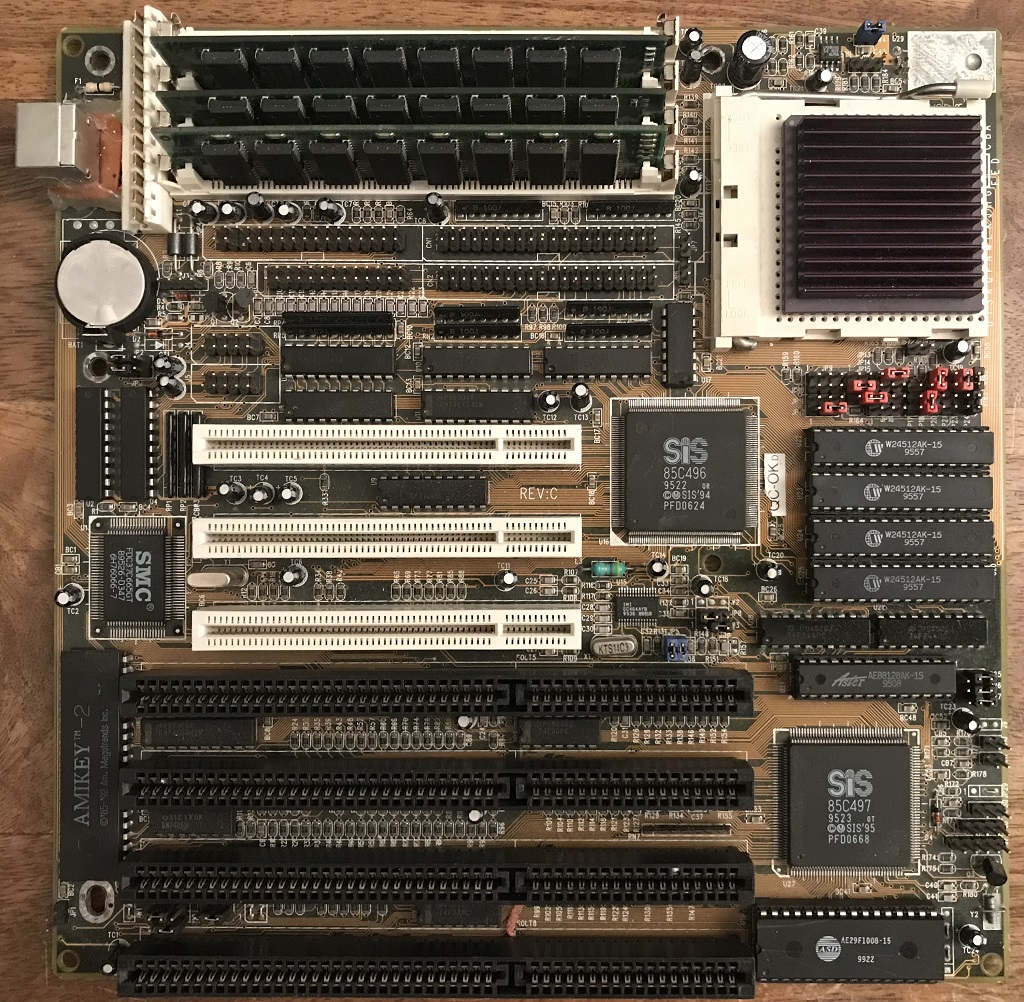
Despite the Lucky Star, this is a pretty reliable board, which, however, fell into my hands being a very battered life. The CMOS memory battery leaked, there was no BIOS chip with BIOS, the keyboard connector was almost destroyed by corrosion, and there was no power transistor in the 3.3V voltage regulator. Restoring the keyboard connector and other damage from the battery was not difficult, but the consequences of vandalism were sadder. There are countless revisions to 486E, and the peripherals are different for everyone, like the voltage regulator. I decided not to restore the last one at all, it’s enough for me that the board works with processors designed for 5 Volts, I don’t need a regulator for this. And I did not find BIOS specifically for my revision. The SMC multicontroller is installed on my board, but such BIOS was not available anywhere. In the end, however, the revision version with the multicontroller UMC came up almost perfectly.

We install 12 MiB of memory on the board. The motherboard only supports FPM, so what we are rich in is welcome, but 12 MiB for 1994-1995 is an impressive amount of memory. Before the release of Windows 95, 4 MiB was considered the standard, after it the requirements rose sharply to 8 MiB and went on to grow further. But this is already the end of 1995 - the beginning of 1996. And we have the 1994 setup, with Windows 3.X, here 12 MiB is almost a high-end level.

I will use the S3 Savage4 card to display the video. This is a card from a completely different time, from 1999. But this is the only S3 board that was at hand, and when it comes to Windows 3.x, I have one simple rule: the S3 graphics card. Yes, I would like to see the S3 Trio32 here, but even for the Savage4 released in 1999 there is an excellent driver for 16-bit Windows. It’s unfortunate that the company all turned out so sadly.

I will use microdrive as a hard drive. Usually in such cases, I would use a flash drive, but we are talking about capturing video, that is, a lot of dubbing, and, I'm afraid, the flash can become bad here.

The network board is unremarkable, but it will help to transfer software and the results of work from / to more modern hardware.
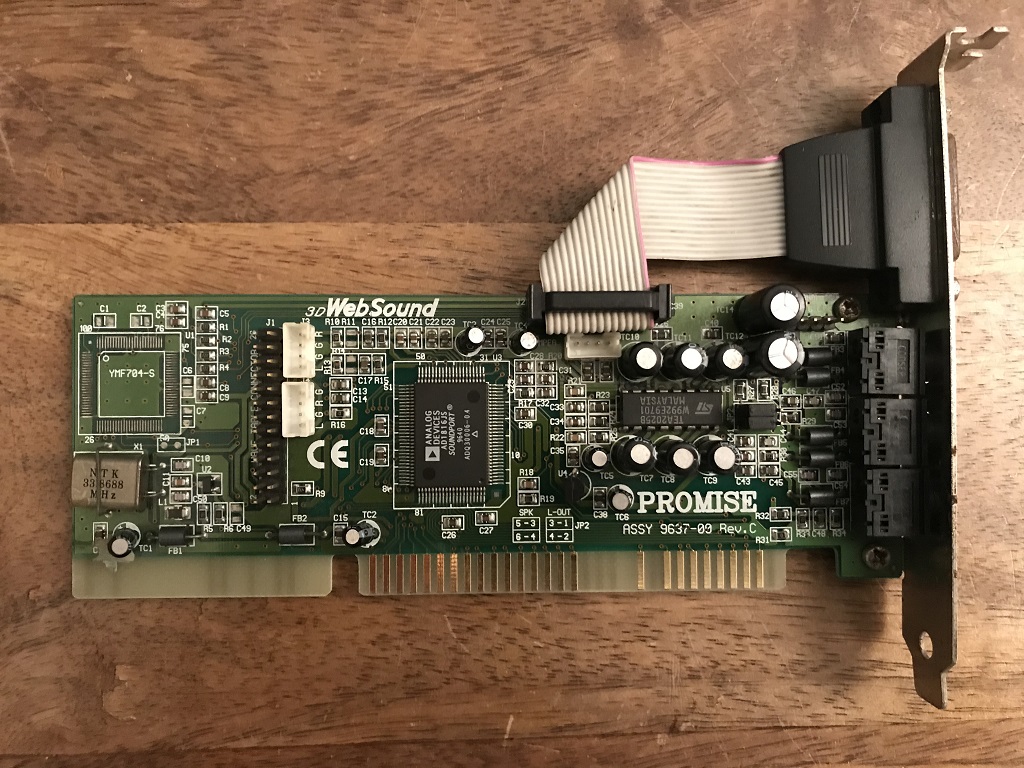
Well, the sound. Nothing special either. The Sound Blaster clone is also pretty buggy. But we don’t need much. 8 bits mono with a sampling frequency of 22 kHz, our computer can’t handle it anymore.
So, let's start by installing DOS. Version 5.0 will be just right, although 1994 is just 6.22, the latest version of MS-DOS, as a separate OS. But in our case, the differences are small.

Anyway, the main work will be done under Windows 3.11:
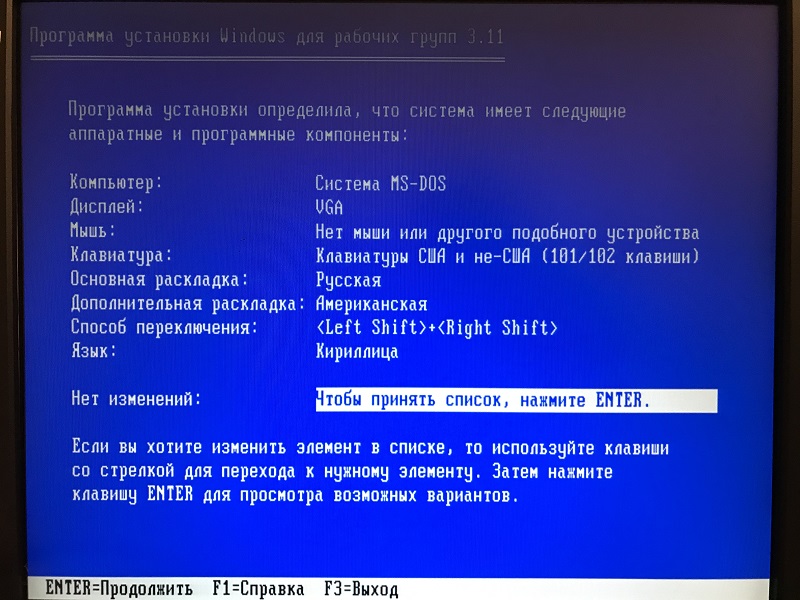
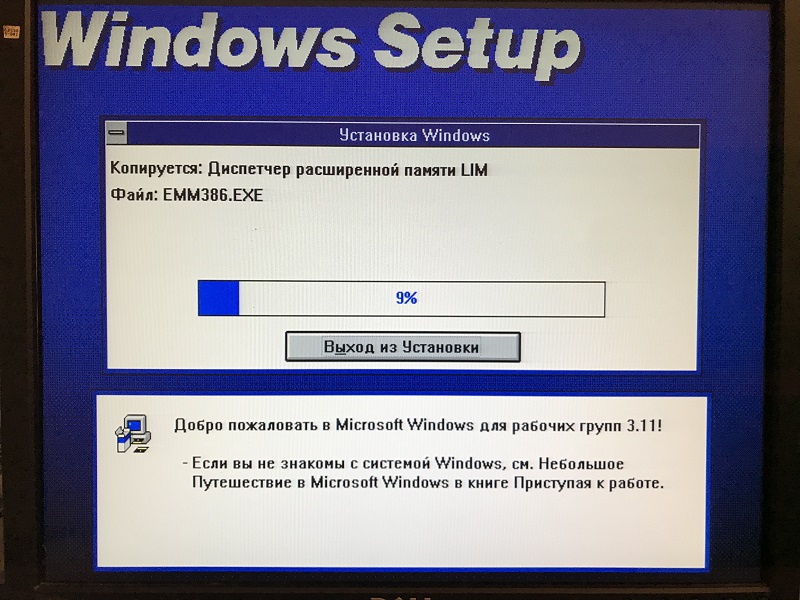
3.11 this is for the network. I want a simple data transfer, so I need TCP / IP. Not only was it not in the standard OS package, it also required the installation of Win32s, a 32-bit add-on for Windows 3.X, which provided the Win32 API subnet.

After installing TCP / IP, you can climb onto a network drive for the rest of the drivers.

And this is why I love S3:
image before installing the S3 driver:
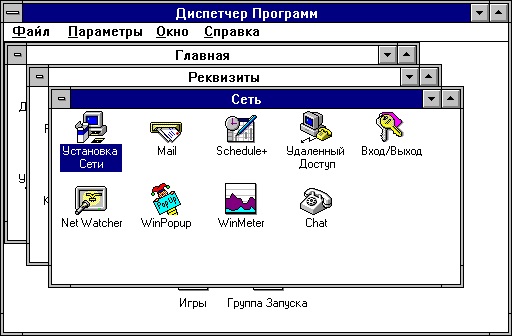
and after:

You can now install Adobe Premiere 1.1.

Do not forget to reboot, as after any installation:
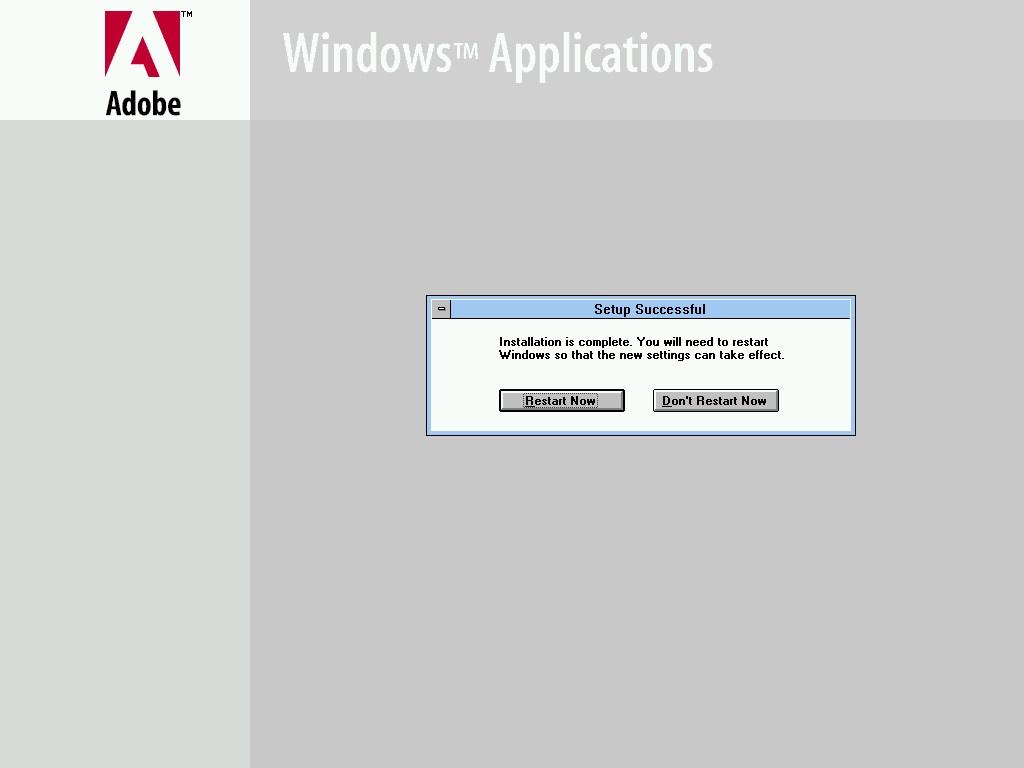
Video for Windows is already included in the package, so all that remains is to install the miro Video driver. The miro driver kit includes a utility that allows you to check the data transfer speed from / to disk. We'll see:
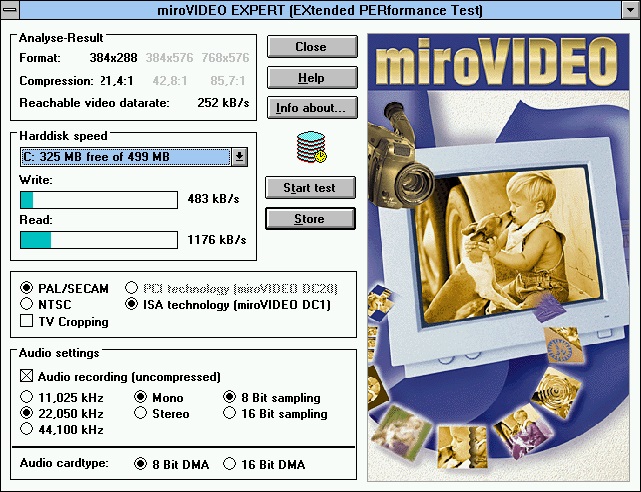
Hmm, not a lot. Well, what is what is. But now, after countless reboots, you can begin to have fun. I don’t have many composite video sources, so I’ll start with the simplest that is always at hand: ZX Spectrum. Let's try to capture the gameplay video. A peculiar twitch a la 1994 will be. Yes, the sound output in the ZX Spectrum is not provided by design, so the video will be dumb. But I will still capture the sound in order to assess the real load. The sound will be uncompressed PCM, 8 bits 22 kHz. And no, compression does not improve the situation, rather, on the contrary: 486-66 is unable to unpack MP3s on the fly even with the lowest bitrate, what can we say about packaging in parallel with video capture?

So, the first feature. When capturing a video, the preview window does not work, and it is completely unclear what exactly we capture. Fortunately, the signal from the input of the capture card is directly forwarded to the output, and using an external monitor with a composite input, you can see what we have at the input. Also, before capture, the program offers to deploy the capture buffer file. I suppose to avoid a lot of search time when writing to a fragmented disk. I have deployed 50 MiB. Getting started:
A long and boring video from the spec
For a composite signal captured at 486m in a resolution of 320x240 (yes, this Spectrum is an NTSC harlequin), the quality is quite good! Let's see what's inside ... Yes, it's MJPEG. An uncompressed video card cannot capture at all, when you turn off compression in the capture settings, we see the following:

Of the 8.5 thousand captured frames with a resolution of 320x240 and a speed of 25 frames / sec, 100 were skipped. I think due to the fact that the captured file was 3 times the size of the preallocated buffer. But, in general, this is a very good result! After the capture, the video is copied from the disk buffer to a separate file, and this operation takes quite a lot of time, quite comparable to the capture itself. It should be noted that I am impressed with the capture quality. It definitely matches VHS. I was preparing for a much worse result, and the results that I got with my first video capture card (which was a regular PCI card from the Aver Media TV tuner) at Celerone in 1996-1997 were probably worse.
Well, let's look at what Adobe Premiere 1.1 was. At the same time, we’ll apply some kind of sound to the video, for fun.

What can I say? Since those ancient times, nothing has changed much in non-linear editing. The same timeline with multiple tracks, separately for video, sound and effects. Everything is familiar and for someone who knows how to iMovie or Blender Video Editor, not to mention modern Adobe Premiere, deal with this version will be very simple. And what a cool one-school transshipment here! It’s just some kind of holiday:
Let me try to create a short video about the benefits of TR-DOS for the ZX Spectrum in the style of 90s!
M-yes, everything is very quick. For the recompression, I used the native codec of the video card, that is, the recompression, in theory, should have been hardware. A 4-minute video was created 2 hours 10 minutes.
And yes, there is hardware compression here. For verification, I tried to render a short 10-second video with different codecs. Here are the results:
- miro MJPEG - rendering time 5 minutes.
- Microsoft RLE - total time 5 minutes (build 256-color palette 1 minute and encoding 4 minutes). But this is a much more lightweight codec.
- Microsoft Video 1 - rendering time 8 minutes.
- Cinepak - 1 hour rendering time.
Well, that’s probably all. It was fun. Interestingly. the board did not cause any difficulties during installation / configuration. That's what German quality means! And the fact that on 486m about 66 MHz with 12 MiB of RAM and a disk of 500 MB, and even under the control of the 16-bit version of Windows, it’s really possible to mount video clips really admires me. I am very happy how I spent these 10 euros, usually everything turns out much more boring.